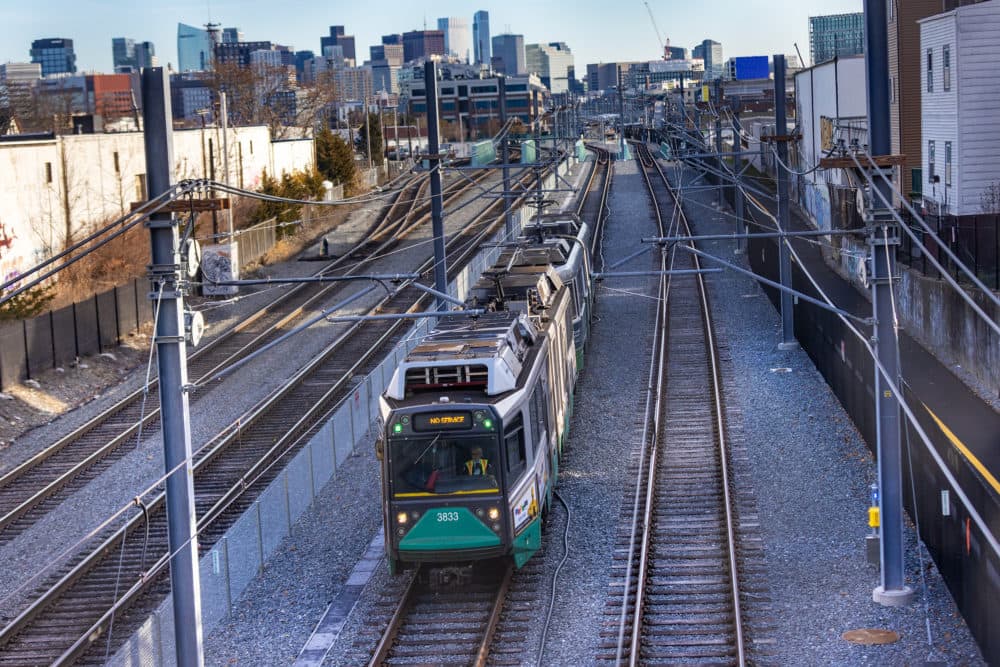Advertisement
Slow zones to continue on MBTA, including Green Line speed restrictions

The MBTA is walking back a suggestion that it would soon get rid of some speed restrictions on the Green Line. More than a week after the T ordered trains to move slower because of failures to confirm past inspections and repairs, MBTA Interim General Manager Jeff Gonneville said Friday afternoon he is "optimistic" the T will be able to replace the end-to-end slow zone across the Green Line with a series of smaller, localized limitations starting Saturday morning.
But Saturday morning, the transit agency tweeted that tests revealed the need to keep the restrictions in place on the entire line for now. Once the agency lifts end-to-end speed restrictions on the Green Line, MBTA officials estimate that an even 25 percent of the four major subway lines will face speed restrictions stemming from the track inspection and record-keeping breakdown, including the exact same combined share of the Red, Orange and Blue Lines — 31.9 percent — that have been subject to mandatory slowdowns since Monday.
Gonneville did not provide an estimate for when the T will be able to return to more normal train speeds across the system, which also continues to operate with less frequent weekday service on its heavy rail lines nine months after officials imposed cuts they said at the time would be temporary.
"We are making progress with our validations. So over the next coming days as well, we're going to start making some incremental improvements and really start lifting some of these speed restrictions," Gonneville said. "But some of these speed restrictions are going to require corrective actions and will take longer than others to resolve and lift. We're actively working on that now and working through those plans."
Since MBTA officials realized they could not provide documentation needed to prove they addressed track problems flagged by Department of Public Utilities inspectors, MBTA engineering and maintenance workers have completed a new batch of inspections on 48 percent of problem areas, and third-party crews have reviewed 74 percent of defects, according to data Gonneville presented.
The MBTA ordered immediate slowdowns across the entire subway system late at night on March 9, two days after DPU Rail Transit Safety Director Robert Hanson wrote six letters ordering corrective action to address problems his inspectors found. On March 10, the T shifted to a vaguely defined patchwork of slow zones on the Red, Blue and Orange Lines, and the agency made a similar move on the Mattapan Line trolley on Thursday.
"When our teams began looking back and looking to get that information, we found there was the documentation breakdown. At that point in time, myself and other senior managers were briefed on this particular condition, and I think as everyone knows, we made the very appropriate decision to ensure the safety of the system to slow the entire system down," Gonneville said Friday. "I fully understand that that was a very bold move. It was a conservative move. But it was necessary at that moment to fully ensure the safety of the system."
Once the end-to-end speed restriction lifts on the Green Line, about 16 percent of that line will be subject to slow zones, according to MBTA data. Slow zones cover 22 percent of the Mattapan Line.
Advertisement
Speed restrictions are more severe on heavy rail. The T said Friday that 80 percent of the Blue Line, 24 percent of the Red Line and 22 percent of the Orange Line are still under slow zones, a combined rate of 31.9 percent that did not budge over the course of the workweek.
The MBTA did not provide any details about where the newly imposed slowdowns are located.
Those rates do not take into consideration slow zones that predated last week's missteps, so the total share of affected track is even higher. Gonneville said the agency next week plans to publish an interactive dashboard detailing speed restrictions across all lines.
"We are ensuring that the information that we're collecting and that the verification and validation process is precise. Because of that, it does take time," Gonneville said. "Each one of these very specific defects has a detailed series of measurements that needs to be taken at every one of these individual locations. That takes time, and it takes time to also do that in between running trains that we're doing every single day."
"So I am satisfied with the amount of progress that we have made as it relates to using engineers and having engineers take those very detailed precise measurements over the past week," he added.
Gonneville's Friday press conference featured little new information about how the T reached the point where its leaders had so little confidence in their own inspection and repair records that they concluded the safest option was to slow down the system.
He mentioned that the MBTA tapped "an independent party" to investigate the documentation failures, but did not elaborate.
While Gov. Maura Healey continues to tout her administration as committed to transparency at the MBTA, a T spokesperson did not shed much additional light.
"The MBTA is finalizing an agreement with the contractor, and will make more information available after the agreement is executed," spokesperson Joe Pesaturo said.
Asked if any employees had been terminated or placed on leave due to the upheaval, Gonneville replied by pointing to the ongoing investigation.
"As that investigation progresses, if there's some determinations that we need to make some personnel changes or some personnel moves, then certainly the MBTA would take that position," he said.
Gonneville continues to serve as the interim top leader of the T while Healey's team searches for a permanent general manager, a process she started in December by hiring search firm Krauthamer & Associates.
Healey did not meet her March 6 deadline to hire a new "transportation safety chief" to oversee the MBTA and other state transportation infrastructure.